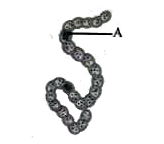Consider the following statements:
Assertion (A): Constructed “Buland Darwaza” at Fatehpur Sikari.
Reason ( R): Akbar built this monument to commemorate the birth of his son Jahangir.
Which on eof the following is correct in reference of above:
Both (A) and ( R) is true, and ( R) is the correct explanation of (A).
Both (A) and ( R) are wrong but, ( R) is the correct explanation of (A).
(A) is true,but ( R) is false.
(A) is false,but ( R) is true.
The correct Answer is:C
Similar Questions
Given below are two statements:
Assertion (A): Natural vegetation is the true index of climate.
Reason (R): Water loving plants are found in moist climate
In the context of the above statements, which one of the following is correct?
View SolutionWith reference to the cultural history of India, consider the following statements:
1. White marble was used in making Buland darwaza and Khankah at Fatehpur Sikri.
2. Red sandstone and marble were used in making Bara Imambara and Rumi Darwaza at Lucknow.
Which of the following given above is/are correct?
View Solution
Knowledge Check
Consider these two statements:
Assertion (A): Akbar constructed the Buland Darwaza at Fatehpur Sikri.
Reason (R): Akbar desired to commemorate his victory.
In the context of these two statements which one of the following is correct?
a) Both A and R are true and R is the correct explanation of A.
b) Both A and R are true but R is not the correct explanation of A.
c) A is true, but R is false.
d) A is false, but R is true.ABoth A and R are true and R is the correct explanation of A.BBoth A and R are true but R is not the correct explanation of A.CA is true, but R is false.DA is false, but R is true.Which of the following statement is correct w.r.t above diagram?
 AA' is mucilaginous sheath and is also found in RivulariaBA' is mucilaginous sheath and is also found in AnabaenaCA' is is also found in methanogensDA' is heterocyst and is also found in Anabaena
AA' is mucilaginous sheath and is also found in RivulariaBA' is mucilaginous sheath and is also found in AnabaenaCA' is is also found in methanogensDA' is heterocyst and is also found in AnabaenaConsider the following statements-
Assertion (A) : Dyarchy means division administrative affairs in two sections.
Reason (R ) : It was introduced for enforcement of responsible governance in Provinces.
Which of the following is correct in the reference of the above?ABoth (A) and (R ) are ture, but (R ) is the correct explanation of (A).BBoth (A) and (R ) and true, but (R ) is not the correct explanation of (A).C(A) is true, but (R ) is false.D(A) is false, but (R ) is true.
Assertion (A) : Mohenjodaro and Harappa cities are dead now.
Reason (R ) : They were discovered during excavations. In the context of the above, which one of the following is correct?
View SolutionConsider the following statements-
Assertion (A) : The structure and characterics of governance remained unitary and central with enforcement of the Government of India Act of 1919.
Reason (R ) : A large part of authority was delegated to Provinces.
Which of the following is correct in the reference of the above?
View SolutionThe age of a man is 4 times his son's age and the sum of their aeges is 60 years. Which of the following represents the above statements?
View SolutionConsider the following:
Tughulqabad
Lodi Garden
Qutb Minar
Fatehpur Sikri
The correct chronological order in which they were built is :
View SolutionConsider the following statements and select correct answer from the code given below :
Assertion (A) : China's growth of population has dramatically slowed down.
Reason (R) : Its fertility rate has declined due to one child per family norm.
In the context of above, which one of following is correct ?
View Solution
